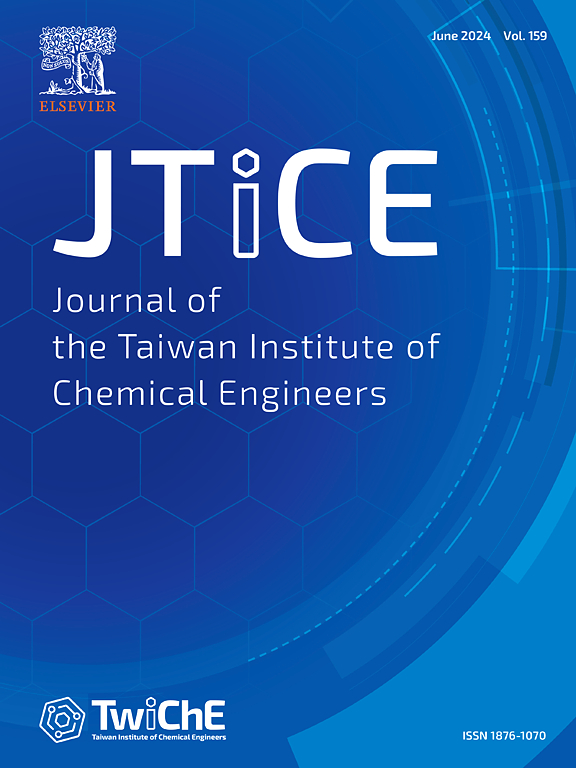太阳能驱动的亚甲基蓝染料的高效光降解和Bi₂X₃-TiO₂(X = S或O?)纳米催化剂的抗菌活性
IF 5.5
3区 工程技术
Q1 ENGINEERING, CHEMICAL
Journal of the Taiwan Institute of Chemical Engineers
Pub Date : 2025-07-09
DOI:10.1016/j.jtice.2025.106266
引用次数: 0
摘要
二氧化钛(TiO 2)是一种被广泛研究的废水处理光催化剂,但其效率往往受到快速电荷重组的限制。用Bi₂S₃修饰TiO₂可以增强可见光吸收和电荷分离,提高其光催化降解污染物和抗菌应用的潜力。方法采用溶胶-凝胶法合成不同Bi₂X₃与TiO₂比的Bi₂X₃-TiO₂(X = S或O?)复合材料。采用x射线衍射(XRD)、场发射扫描电镜(FE-SEM)、能量色散x射线能谱(EDS)、紫外-可见漫反射光谱(UV-DRS)、光致发光光谱(PL)、傅里叶变换红外光谱(FT-IR)、高分辨率透射电子显微镜(HR-TEM)和x射线光电子能谱(XPS)对催化剂进行了表征。考察了日光下亚甲基蓝降解的光催化效率,并对反应动力学进行了分析。与纯TiO₂和Bi₂X₃相比,Bi₂X₃-TiO₂表现出更好的光催化活性,在pH 5下实现了有效的亚甲基蓝降解。清除剂研究证实,超氧自由基阴离子在降解机制中起主导作用,其次是空穴和羟基自由基。H₂O₂和K₂S₂O₈等电子受体的加入显著增强了光降解性。化学需氧量(COD)测定证实了MB的高效矿化,催化剂具有良好的可重复使用性。气相色谱-质谱(GC-MS)分析确定了关键的降解中间体,支持Langmuir-Hinshelwood动力学模型。此外,Bi₂X₃-TiO₂复合材料表现出显著的抗菌活性,使其成为废水处理和抗菌应用的有前途的材料。本文章由计算机程序翻译,如有差异,请以英文原文为准。

Efficient solar-driven photodegradation of methylene blue dye and antibacterial activity of Bi₂X₃–TiO₂ (X = S or O?) nanocatalysts
Background
Titania (TiO₂) is a widely studied photocatalyst for wastewater treatment, but its efficiency is often limited by rapid charge recombination. Modifying TiO₂ with Bi₂S₃ can enhance visible light absorption and charge separation, improving its photocatalytic potential for pollutant degradation and antibacterial applications.
Methods
Bi₂X₃-TiO₂ (X = S or O?) composites with different Bi₂X₃ to TiO₂ ratios were synthesized via the sol-gel method. The catalysts were characterized using X-ray Diffraction (XRD), Field Emission Scanning Electron Microscopy (FE-SEM), Energy-Dispersive X-ray Spectroscopy (EDS), Ultraviolet–Visible Diffuse Reflectance Spectroscopy (UV-DRS), Photoluminescence Spectroscopy (PL), Fourier-Transform Infrared Spectroscopy (FT-IR), High-Resolution Transmission Electron Microscopy (HR-TEM), and X-ray Photoelectron Spectroscopy (XPS). Photocatalytic efficiency was evaluated by methylene blue degradation under solar light, and reaction kinetics were analyzed.
Significant Findings
Bi₂X₃-TiO₂ demonstrated superior photocatalytic activity compared to pure TiO₂ and Bi₂X₃, achieving effective methylene blue degradation at pH 5. Superoxide radical anions played the dominant role in the degradation mechanism, followed by holes and hydroxyl radicals, as confirmed by scavenger studies. The addition of electron acceptors like H₂O₂ and K₂S₂O₈ significantly enhanced photodegradation. Chemical oxygen demand (COD) measurements confirmed efficient mineralization of MB, and the catalyst exhibited good reusability. Gas Chromatography–Mass Spectrometry (GC–MS) analysis identified key degradation intermediates, supporting the Langmuir-Hinshelwood kinetic model. Additionally, the Bi₂X₃-TiO₂ composite showed notable antibacterial activity, making it a promising material for both wastewater treatment and antimicrobial applications.
求助全文
通过发布文献求助,成功后即可免费获取论文全文。
去求助
来源期刊
CiteScore
9.10
自引率
14.00%
发文量
362
审稿时长
35 days
期刊介绍:
Journal of the Taiwan Institute of Chemical Engineers (formerly known as Journal of the Chinese Institute of Chemical Engineers) publishes original works, from fundamental principles to practical applications, in the broad field of chemical engineering with special focus on three aspects: Chemical and Biomolecular Science and Technology, Energy and Environmental Science and Technology, and Materials Science and Technology. Authors should choose for their manuscript an appropriate aspect section and a few related classifications when submitting to the journal online.

 求助内容:
求助内容: 应助结果提醒方式:
应助结果提醒方式:


